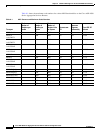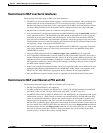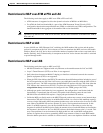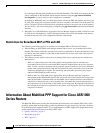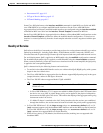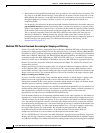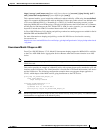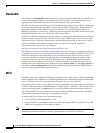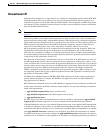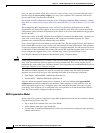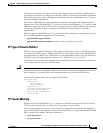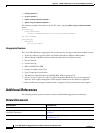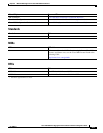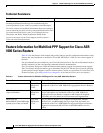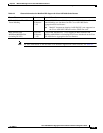
8-12
Cisco ASR 1000 Series Aggregation Services Routers Software Configuration Guide
OL-16506-17
Chapter 8 Multilink PPP Support for the Cisco ASR 1000 Series Routers
Information About Multilink PPP Support for Cisco ASR 1000 Series Routers
Bandwidth
The interface-level bandwidth command must not be used to define the bandwidth at the bundle level
on the virtual template interface or the multilink interface. By default, the bundle bandwidth is the
aggregate of the bandwidth of the individual member links that make up the bundle.
For ATM, the link-level bandwidth is part of the ATM Permanent Virtual Circuits (PVC) configuration
based on the unspecified bit rate (UBR) or variable bit rate (VBR) configurations. The member-link
bandwidth cannot be set for an MLPoE session on a PTA device. To define the bandwidth for an
MLPoE-type bundle on a PTA device, a QoS policy must be applied to the bundle interface that shapes
the bundle bandwidth at the class-default class with a parent shaper.
In PPPoE and MLPoE broadband networks, the DSL access multiplexer (DSLAM) placed between the
customer premises equipment (CPE) and LAC or PTA, inserts a PPPoE vendor tag. This tag includes
information such as, media rate, characteristics, and identification pertaining to the circuit or session.
For more information about Ethernet-based networks, see DSL Forum TR-101 Migration to
Ethernet-Based DSL Aggregation April 2006 at:
http://www.broadband-forum.org/technical/download/TR-101.pdf
The PTA passes media-rate information to the RADIUS server for selecting an appropriate QoS policy
to the bundle session based on the reported bandwidth. In the context of MLP over LNS, the LAC passes
media-rate information to both the RADIUS server and the LNS router. The LNS router uses the
media-rate information to define the bandwidth of the corresponding member-link session. If the
upstream connection at the LAC is MLPoE, MLPoEoVLAN, or MLPoEoQinQ, the DSLAM may
provide the media rate information to the LAC. If the DSLAM does not provide the media rate, the
member-link session bandwidth can be configured using the l2tp tx-speed rate and l2tp rx-speed rate
commands within the vpdn-group configuration command or downloaded from the RADIUS server
using the l2tp-tx-speed and l2tp-rx-speed attributes.
MTU
For MLP Virtual Access bundles (IP and IPv6), the default Layer 3 MTU value is 1500. When the MLP
bundle's member links are Ethernet, as in MLPoE, MLPoEoVLAN, and MLPoEoQinQ, the default MTU
value of 1500 may cause an issue when sending IP packets that are close to this size.
For example, when a router sends a 1500-byte IP packet over MLPoE, the actual packet size transmitted
is 1528: 14 (Ethernet header) + 8 (PPPoE header) + 6 (MLP header) + 1500 (IP) = 1528. The peer router
drops the incoming packet as a giant because it exceeds the default expected maximum packet size.
The 1500-byte MTU size does not take into account any PPPoE or MLP header overhead, and hence,
causes packets greater than 1493 bytes to be dropped by the peer.
To address this issue, perform one of the following tasks:
• Lower the MTU on the MLP bundle to 1492.
• Increase the MTU on the Ethernet interface to 9216, the maximum MTU size that the Cisco ASR
1000 Series Aggregation Services Routers support.
Note In the Cisco ASR 1000 Series Route Processor 1 (RP1), 2RU, and 2RU-Fixed chassis, the MTU size for
the Management Ethernet interface (interface gigabitethernet 0) is limited to 2370 bytes.



